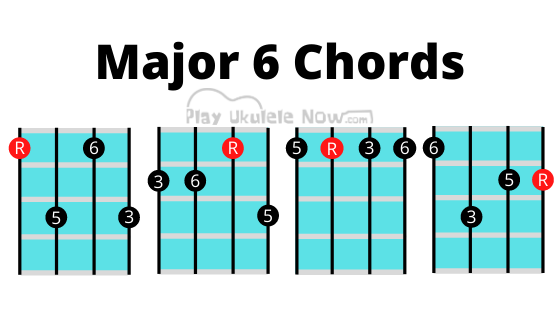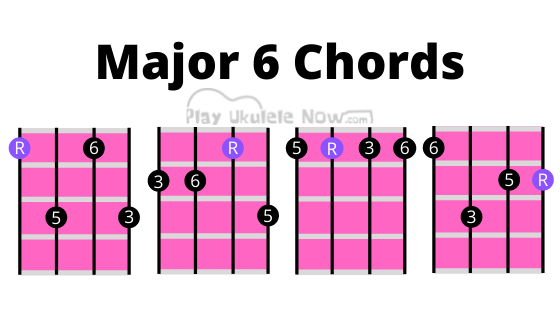And learn HOW TO USE them!
You will Learn More and Play More with Play Ukulele NOW.
Find out for yourself why teachers and students have depended on Play Ukulele NOW Methods and Songbooks since 2009
Find out for yourself why teachers and students have depended on Play Ukulele NOW Methods and Songbooks since 2009
DISCLOSURE: THIS POST MAY CONTAIN AFFILIATE LINKS, MEANING I GET A COMMISSION IF YOU DECIDE TO MAKE A PURCHASE THROUGH MY LINKS, AT NO COST TO YOU. PLEASE READ MY DISCLOSURE FOR MORE INFO.
Find all my chord related posts here: Chord Tips and Tricks
Here you'll not only learn the major 6 chord forms - but you'll learn how to use them!
The biggest problem with chord charts and chord books is that they never tell you how to use the chords.
Embellished and altered chords are easy to use if you learn a few simple rules on how to use them.
You will be able to instantly spice up any chord progression - even as a beginner - after this lesson.
WATCH FIRST:
In this NEW video you'll learn some cool tricks to find and use beautiful major 6 chords!
Here is the uke I play in the video (mine is an older version):
This is one of my favorite ukes!
Related stuff on patreon:
NEW! Follow the RED DOT #6 - SEE HOW MAJOR 6 chords relate to dominant and major 7 chords (patreon)!
About major 6 chords
These chords have a happy, relaxing sound.
A major 6 chord is simply a major chord with an added 6th.
A major chord is built with 4 notes. The root note (1), a major third (3), a perfect fifth (5) and a major sixth (6).
These chord forms - like many other ukulele chord forms - are based on drop 2 jazz chords. These are the exact forms that a jazz guitarist would use when playing a major 6 chord on the top 4 strings.
Here are the shapes for the major 6 chord on the ukulele:
You may notice that these look like some other chords you are already familiar with!
They are the same shapes that you would use for minor 7th chords!
Relative minors
For each of the major 6 chord shapes above there is a relative minor seventh chord that contains the same notes and can be played using the exact same chord shape.
C6 consists of the notes: C, E, G, and A
A minor 7 consists of the notes: A, C, E, and G
Therefore: the chord shape to make a major 6 chord and a minor seventh is exactly the same!
This will come in useful in helping you to find the major 6 chords if you already know the minor seventh chords.
For example: if you wanted a C6 chord for your chord progression you simply find the relative minor 7th chord. You locate it like so: count up six notes (it's a 6th higher), just like this:
C, D, E, F, G, A
The 6th of C would be A. so, the relative minor 7th chord would be Am7. If you know how to play an Am7 chord you will have your C6! Same chord.
This means C6 and Am7 with share the exact chord shape and contain the exact same notes.
GRAB YOUR (PDF) 6 CHORD CHARTS HERE (Charts show 6 chords all the way up the neck)
How to use the major 6 chords
The way the major 6 chord is most commonly used is as an embellishment for the I chord.
Here is a ii, V, I progression in the key of C - harmonized with 7 chords:
This chord progression comes from a C scale harmonized with seventh chords.
The C scale is harmonized with 7th chords like so:
(I) Cmaj7, (ii) Dm7, (iii) Em7, (IV) Fmaj7, (V)G7, (vi) Am7, and (vii) Bm7b5
Notice roman numerals are given to each scale degree, this is where the ii, V, I progression above comes from.
Using the major 6 as an embellishment for the I chord
Here we have the same progression we just looked at but with I chord embellished as a major 6:
We can also alter the chord like so - starting with the major seventh and resolving with the major sixth.
No matter what the progression is you can swap the I chord out for a major sixth.
So, for you beginners - it's as easy as figuring out what the I chord is and swapping it out for a major sixth.
Major 6 as an embellishment for the I and the IV
Let's look at a different progression for a moment and we'll embellish two chords with the major sixth.
Here's a I, vi, IV, V progression:
If you've been following along you'll see we might have a problem here.
We have an Am7 in this progression and we've already learned that the Am7 is the same chord as the C6 so if we embellish the I chord there will be no change when we move to the vi chord, since the two chords will contain the same notes and use the exact same chord shape.
So, I'll have to show you another trick here before this progression will work for our major sixth embellishments.
We're going to do something that's very commonly done with a progression like this - a quality upgrade.
Quality upgrade
We're going to upgrade the chord quality for the Am7.
Changing chord quality means that we're changing it from a minor to a major, diminished, dominant etc...
Here we change the Am7 to an A7 (a dominant 7 chord rather than a minor 7).
A quality change for the vi chord in a progression like this is very common. The new chord (A7) will lead better to the next chord.
Here we have the progression with the Am7 upgraded to the A7:
Now we're ready to embellish the I and the IV chords to make them major 6 chords.
NOTE: After the quality upgrade we get a I, VI, IV V progression - rather than a I, vi, IV , V
Here's or new progression:
Here's an interesting note: We know that the C major 6 chord (C6) has the same notes, fingering and sound as the Am7 chord. And we know that the F major 6 chord (F6) has the same notes fingering and sound as the Dm7 chord.
So, what we have here gives us the same effect as if we swapped the I chord for the iii chord (CM7 for Dm7) and we swapped the IV chord for the ii chord (FM7 for Dm7). This is actually chord substitution - it's something that's very commonly done and it's another way to arrive at a progression that sounds exactly the same as the progression above.
It would of course be a different progression, it would be a iii, VI, ii, V progression, a very popular progression in jazz and popular music.
The chords would be: Am7, A7, Dm7, G7.
It's good to know things like this because it helps us to better understand chord progressions overall.
Another look at altering a chord - CM7 to C6 with a I, IV, V progression
Here's another look at altering a chord with a different progression:
Altering a chord like so is a great way to add color to your chord progressions.
Other Uses and variations
Major 6 chords appear all of the time in modern music as endings.
This brings us to how we might vary the chord. When the major 6 appears as an ending, it usually appears without the 5th. Often times the root note will be doubled as well. It won't be necessary to double any notes if you take out the fifth - but you can if you like.
The best practice, if you'd like to experiment with this, is to use it as an ending with a 3 note chord including the 1st, 3rd and 6th. Simply take out the 5th on the chord diagrams presented here.
Share these pictures on your favorite social media sites, so your friends can stop over and take a look at how to use these beautiful chords.
If you have any questions please drop a comment below. I'd love to help you.
|
Chord |
Written |
Formula |
|
Major 6 |
6 (C6) |
(1), 3, (5), 6 |
|
Major 9 |
M9, maj9, (Cmaj9) |
(1), 3, (5), 7, 9 |
|
Major 6/9 |
6/9 (C6/9) |
(1), 3, (5), 6, 9 |
|
MAJOR 9 #11 |
maj 9#11, maj 9+11 (Cmaj9+11 ) |
(1), 3 and-or 9, (5), 7, #11 |















.png)





No comments:
Post a Comment